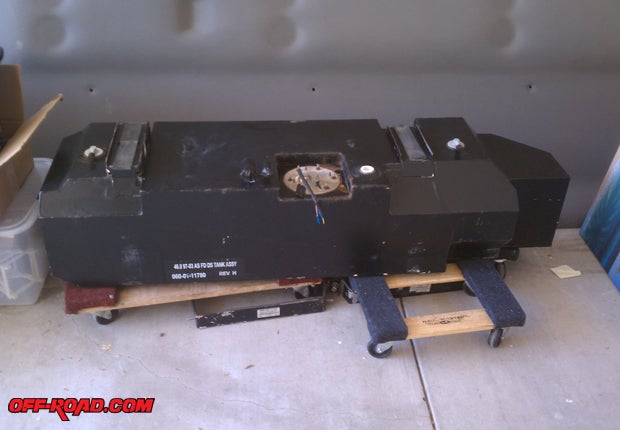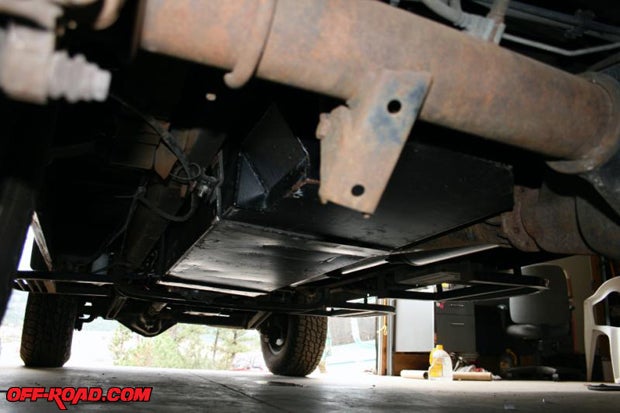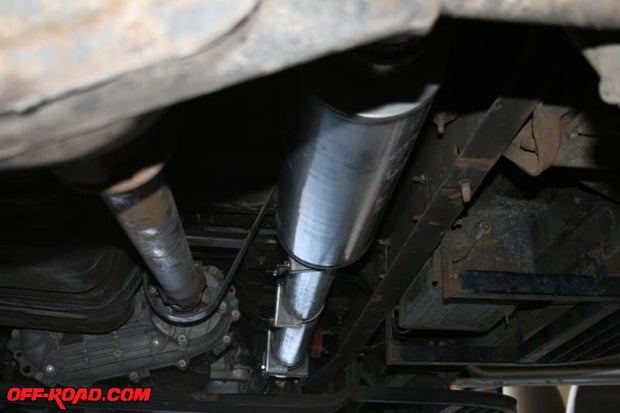
Check out Previous Motovan Articles:
Motovan Part 3
Motovan Part 2
Motovan Part 1
Project Motovan is moving right along, although at a little slower pace than expected which is unfortunately sometimes the case with a custom build. You might recall in our last installment we left the van in Colorado with Derek from Colorado Campervan to build the interior of the van and make some mechanical upgrades. Upon completion of the last article, Derek was making great progress with the installation of the windows, insulation and some of the custom cabinetry that holds the microwave and the National Luna Fridge/Freezer combo. Since that time, we also tasked Derek with installing a larger fuel tank, an exhaust system and a programmer.
During the 4x4 conversion process, the stock 38-gallon fuel tank is actually modified to clear the transfer case. Due to this need to clear the transfer case on the extended van like ours, the fuel capacity drops from 38 gallons down to approximately 28-30 gallons depending on who you talk with. With our 4x4 7.3, the realistic mileage with our van is going to be anywhere from 12.5-15 MPG depending on our driving habits, how loaded down we are and if we are towing or not. Sticking with the modified tank only leaves the van with a safe range of about 300-350 miles before finding diesel fuel starts to become a necessity.

Try searching for an aftermarket fuel tank for one of these 4x4 converted vans and you wonít discover much. A company called Transferflow used to sell a few different tank options to the public, but now generally they wonít even acknowledge they still make one. In fact, they once offered a huge 46-gallon custom tank for the stock location and an additional 20+ tank that fit behind the rear axle and would pump fuel into to the main tank to keep things balanced. From doing a lot research, it seems they still actually make the 46-gallon fuel tank but in order to purchase it you have to go through one of their approved installers such as Sportsmobile or Quadvan. The cost for purchasing and installing such a tank, ah, is around a mere $2K!

Luckily for us we scored big time by scanning Craigslist and finding a used Transferflow tank out of a totaled Sportsmobile for just $315. Upon emailing the seller it turned out he had just offered it to a gentleman the day before who was supposed to drive to pick it up that next weekend. Amazingly the seller emailed me back the next week saying the guy did buy it but said since he had the newer 6.0L diesel with a different transmission it wasnít going to fit easily. After obtaining the original buyerís contact info, I was able to contact him and he verified it wasnít going to be worth his time to try and make it fit so he would be open to selling it to me. The guy was a total gentleman and only charged me the same price he had paid for it when he could have easily jacked up the price on me. He helped me load up the tank and I was on my way, having met yet another great van nut.
I took the tank to a local mailbox/shipping store and they were able to carefully box it up, surround it with foam and ship it off to Colorado Campervan for me. Once the tank arrived in Colorado safely, Derek had some help dropping the original tank and prepping the 46-gallon Transferflow tank for installation. I asked him to add a hole in the vent spout just inside the tank to help to prevent the slow filling of the final 10 gallons. This was an issue many other Transferflow tank owners were really complaining about and something I wanted to avoid. In addition to the vent hole Derek also installed the additional pickup tube that would feed diesel fuel to the Espar D2 Diesel heater that will heat the van while camping.

Just as the search for a larger fuel tank was met with few results, the same was the case for a performance exhaust system for the diesel van. Luckily, you only need one good result! After some extensive searching, we finally discovered that Diamond Eye Performance (http://www.diamondeyeperformance.com/) actually offers a complete turbo-back 4-inch system designed for our specifically for the diesel Ford van. Installing a turbo-back exhaust system will help reduce the exhaust gas temperatures that can be so destructive to a diesel engine. After a call to Diamond Eye Performance, we learned the exhaust system is in fact an aluminized complete turbo-back system that includes everything needed to mount to the van, including instructions. One thing the instructions are also clear to mention is ďIf your vehicle is equipped with a catalytic converter, it is unlawful to remove.Ē Our van didnít come from the factory with a catalytic converter but I have seen at least one dually truck with the 7.3 that had one. Something to keep in mind with the ever-more restricting emission laws and now the required California smog tests for diesels of certain years.

The exhaust system arrived at Derekís shop a few days later where he opened the box and made sure everything was there. Upon discussing the exhaust system with Derek he was pleasantly surprised at how complete and well-thought-out the system was. There were plenty of hangers provided in the kit for a thorough mounting, reducing the chances for future vibration-related damage. Derek commented on how smooth the actual install went, with everything fitting together easily like it should. There was no need to make an adjustments or custom bends as it seems is sometimes the case with exhaust systems. We went ahead and installed the optional stainless-steel tip as well to round out the system.


In order to monitor the exhaust gas temperature and other engine vitals we had the option of going with a set of independent gauges or going with a tuner that has the gauges built in. Due to the fact that the 7.3 diesel in the van does not have an intercooler, trying to go with separate gauges and a fancy custom tune to extract the maximum power from the engine didnít seem all that practical like it has in past vehicles. The engine is so wedged in the van it doesnít seem too smart to generate that kind of heat when it has no place to escape too. Plus, since the van is going to be used primarily to transport dirt bikes, do some very light wheeling and mostly camp out, performance is not at the top of the list; durability is. A simple and effective solution in our case was to go with the Edge Evolution (http://www.edgeproducts.com/) programmer.

The Edge Evolution programmer comes with three adjustable tunes but more importantly the ability to monitor four different things at once on the display. Having all of this combined into one simple unit seemed like right path on this build. For us being able to monitor the EGTs, tranny temp, RPM and boost all at once is great, and the fact that it has a few tunes to boot just makes it icing on the cake. Derek installed the Exhaust Temp probe, plugged in the ODBII connection and stuck the pod on top of the dash. Upon initial install the unit would display the vitals we had set but it was giving an error when trying to actually program. After putting in a call to Edge they loaded up something new on the device through the computer and their Fusion software and it worked. A little frustrating at first but we were able to find the solution in the end.
Being on a tight schedule I flew into Denver on a Friday night and had two days of driving back to California to get a feel for some of the modifications that had been made to the van. I will save the interior discussion for our next article, but I will say the Quiet Ride insulation definitely helps to quiet down the van. With the insulation and carpet in the van, that hollow feeling of the past is now replaced with a more solid and quiet feeling. In addition that clicking of the 7.3 is much dulled compared to what it was, although it is still not as quiet as a V10.

The Diamond Eye exhaust system gives a nice throaty sound but is in no way obnoxiously loud. In fact, in most cases it seems to be similar to stock, possibly offset a little by the insulation. At highway speeds below 70 mph and under 1800 RPM, both the exhaust and the engine are extremely quiet. In fact, all day driving under 70 mph was very comfortable. Once you get between 70 and 75 mph, however (or above 1800 RPM with our 3:55s), the exhaust develops a definite drone-type sound. If the turbo is working it is more pronounced, such as going up a grade. If going downhill and in that range it is quiet, but then the engine isnít working much. Go a bit above that range and the drone sound goes away. Driving across country when the speed limit was 75 and the engine working up the grades the drone would get annoying once in a while if I didnít have some music on, but at other times I didnít notice it. All in all, it is worth it to gain the benefits of having a larger exhaust on the diesel.
Since the Edge programmer had thrown an error initially while trying to program the van I just used it for monitoring primarily the EGTs, boost and RPM on the drive home. At one point the EGTs hit 1400 degrees for a few seconds. Depending on who you talk with some will say that is too high and others will say 1500 or 1600 for anything over 10-20 seconds is too much. Either way, I wasnít too excited about seeing the EGTs that high even though it was only for a few seconds. Once I was back in California and tech support helped get the Edge working I set it to the Tow mode. As far as performance increase, it definitely helps the off-the-line acceleration of the van, but I wouldnít call it drastic in any other areas. There are two other programming levels to try out, but since switching to the tow mode the EGTs havenít gone above 1300 degrees.
The fuel tank was 110 percent worth the effort! It is such a great feeling to be driving across country not having to worry about finding the next diesel station. The tank fills up completely with no extra effort, and the gas gauge doesnít even budge from full until over 100 miles goes by on the odometer. Getting a 450-550-mile range provides a lot of comfort for road trips. It is also nice not to have to worry about limiting the use of the Espar diesel heater during cold nights because of trying to conserve diesel fuel. The only addition I would like to make is to add some skid plate protection to the tank. It already has a few spots where it has rubbed some trail goodies, and I want to make sure not to make any permanent damage.
All of the large mechanical installs are basically complete on the van. The drive back was eventful to say the least! With a breakdown within miles from leaving Colorado, snow through the passes and a massive rain and wind storm, the drive home was quite an experience and one that I will cover more in our next article. The latest status on the van is that most of the interior work is done with some rework and finishing work required and in process. In the meantime, we have already attended a local meet up of van enthusiasts and had a blast discussing and comparing vans. Check back for full coverage on the interior, wiring and appliances.
Check out Previous Motovan Articles:
Motovan Part 3
Motovan Part 2
Motovan Part 1


 Your Privacy Choices
Your Privacy Choices